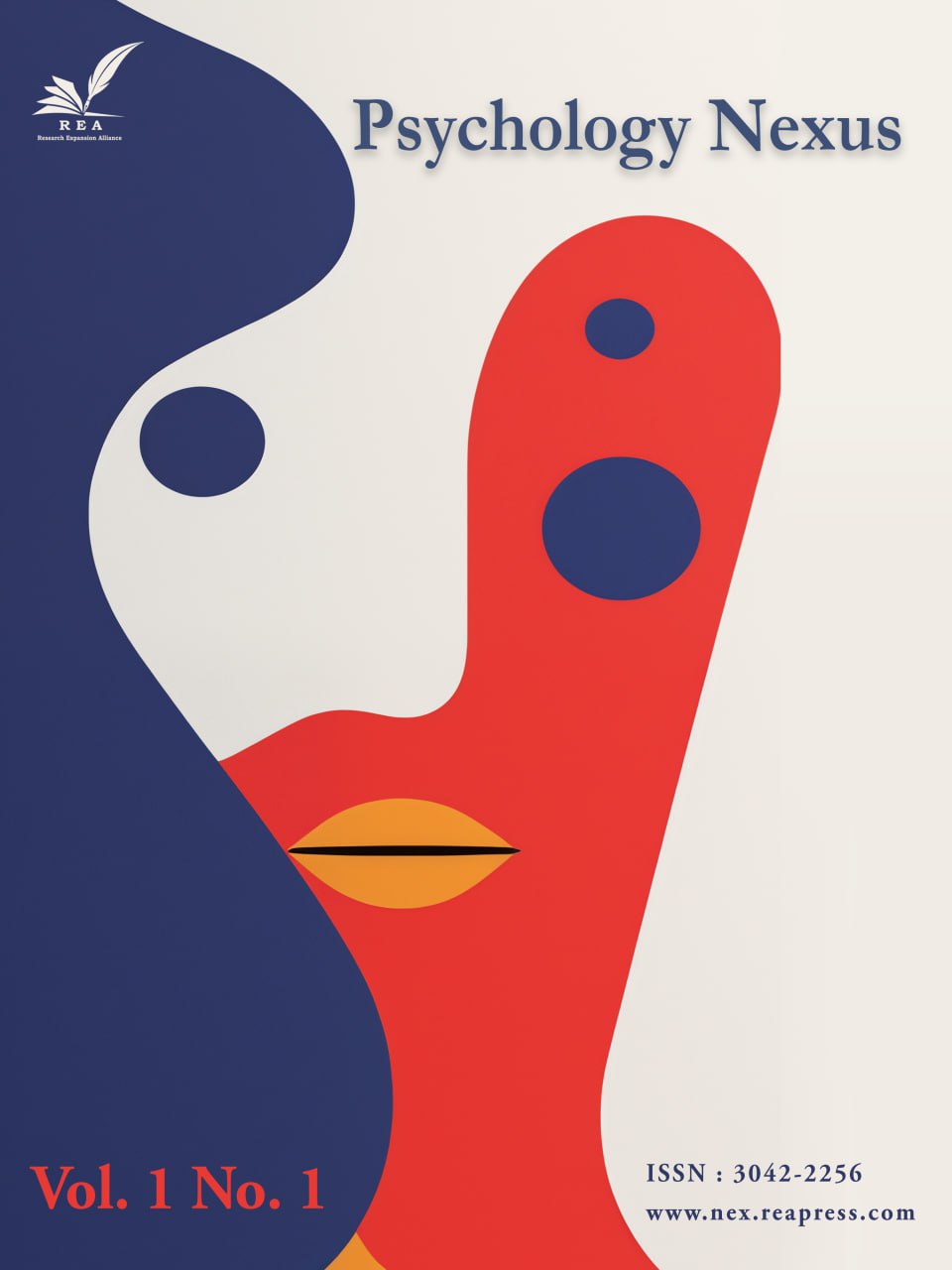The Relationship between Premenstrual Syndrome Symptoms and Alexithymia with Hypochondria: Mediating Role of Marital Satisfaction in Women Attending a Women's Clinic
Abstract
This study was conducted to determine the relationship between Premenstrual Syndrome (PMS) symptoms and alexithymia with hypochondria, with marital satisfaction as a mediator, in women attending women's clinics in Tehran city. The research, in terms of objective, is applied and, in terms of methodology, is descriptive-correlational, similar to Structural Equation Modeling (SEM). The research population included all women who visited women's clinics in Tehran in the year 2024. The sampling method used was purposive sampling, selecting participants based on convenience and their willingness to participate. Among the visitors to 10 selected women's clinics in Tehran (chosen based on the number of visits related to premenstrual symptoms), a sample size of 210 women was selected, which satisfies the minimum requirement for SEM analysis. Data were collected using questionnaires designed to measure premenstrual symptoms, hypochondria, alexithymia, and marital satisfaction. Descriptive statistics (mean and standard deviation) and inferential statistics from the SEM hypothesis test were utilized based on path analysis. The results indicated that PMS has a direct effect on hypochondria in women, and alexithymia also directly influences hypochondria in women. Additionally, premenstrual symptoms indirectly affect hypochondria through the mediating role of marital satisfaction, and emotional suppression indirectly impacts self-care agency through the mediating role of marital satisfaction.
Keywords:
Premenstrual syndrome symptoms, Alexithymia, Hypochondria, Marital satisfactionReferences
- [1] Akhlaghi, F., Hamedi, A., Javadi, Z., & Hosseinipoor, F. (2004). Effects of calcium supplementation on premenstrual syndrome. Razi journal of medical sciences, 10(37), 669–675 (In Persian). https://rjms.iums.ac.ir/article-1-214-en.html
- [2] Azhary, S., Karimi Chatrudi, A., Attarzadeh, R., & Mazloom, R. (2005). Officacy of group aerobic exercise program on the intensity of premenstrual syndrome. The Iranian journal of obstetrics, gynecology and infertility, 8(2), 119–28 (In Persian). https://www.sid.ir/paper/64450/en
- [3] Banaian, SH., Parvin, N., & Kazemian, A. (1998). The investigation of the relationship between mental health condition and martutal satisfaction. Avicenna journal of nursing and midwifery care, 14(2), 52-62 (In Persian). http://nmj.umsha.ac.ir/article-1-1024-en.html
- [4] Khalatbari, J., & Bahari, S. (2010). Relationship between resilience and satisfaction of life. Journal of educational psychology, 1(2), 83–94 (In Persian). http://noo.rs/aq0sA
- [5] Davoodvandi, M., Navabinejad, S., & Lotfi Kashani, F. (2011). The effectiveness of group cognitive– behavioral instruction on decreasing physical symptoms of premenstrual syndrome. Medical science journal of Islamic Azad Univesity-Tehran Medical Branch, 21(2), 114–120 (In Persian). https://tmuj.iautmu.ac.ir/article-1-453-en.html
- [6] Salehi, L., & Salehi, F. (2007). Comparative study of vitamin B6 versus placebo in premenstrual syndrome. Scientific journal of Kurdistan University of Medical Sciences, 12(3), 42-49 (In Persian). http://sjku.muk.ac.ir/article-1-37-en.html
- [7] Abedian Kasgari, K., Shahhosseini, Z., & Danesh, M. (2008). Assessment of starch dietary regimen regarding pre-menstrual syndrome among high school students in Sari during 2007. Journal of Mazandaran University of Medical Sciences, 18(65), 19–27 (In Persian). https://jmums.mazums.ac.ir/article-1-476-en.html
- [8] Connor, K. M., & Davidson, J. R. T. (2003). Development of a new resilience scale: the Connor-Davidson resilience scale (CD-RISC). Depression and anxiety, 18(2), 76–82. https://doi.org/10.1002/da.10113
- [9] Tavassoli, A., & Eman Elahi, M. (2015). Examining the impact of couples’ awareness of PMS (premenstrual syndrome) on marital satisfaction. International conference on humanities, psychology and social sciences, Tehran, Iran. Civilica. (In Persian). https://www.sid.ir/paper/836214/fa
- [10] Assali, R., Jalal Marvi, F., Ansari, F., & Lashkardost, H. (2015). Premenstrual syndrome and the marital relationship. Journal of North Khorasan University of Medical Sciences, 7(2), 465–473 (In Persian). http://dx.doi.org/10.29252/jnkums.7.2.465
- [11] Shaahmadi, F., Movahed, E., Shojaei, S., Zareipour, M. A., Lotfi mine blagh, B., Ameri, M., & Sadeghi, S. (2018). The relationship between the intensity of premenstrual syndrome symptoms and marital satisfaction among the couples of Kerman city. Journal of research development in nursing and midwifery, 15(2), 14–21 (In Persian). http://dx.doi.org/10.29252/jgbfnm.15.2.14
- [12] Alijani, M., Roshan Chesli, R., Isamorad Roodboneh, A., & Mehrinejad, S. A. (2023). Structural model of premenstrual syndrome based on marital satisfaction and personality traits with the mediating role of early maladaptive schemas. Journal of research in behavioural sciences, 20(4), 693–706 (In Persian). http://dx.doi.org/10.52547/rbs.20.4.10
- [13] Toorani, S., Pashaee, L., & Gatresamani, Z. (2012). Investigating the relationship between premenstrual syndrome and tolerance in predicting marital conflicts among the married women in Tehran. Woman & study of family, 17(17), 51-66 (In Persian). https://www.sid.ir/paper/206355/en
- [14] Modares Gharavi, M., Janfada, M., & Seyed Hosseini, A. S. (2020). Transactional analysis training on reducing symptoms of premenstrual syndrome and alexithymia in 20-25 years old females in Mashhad. Middle eastern journal of disability studies, 10(16), 16 (In Persian). http://jdisabilstud.org/article-1-1226-en.html
- [15] Galeh dar, M., & Mohtasham, L. (2016). The relationship between awareness of premenstrual syndrome and marital satisfaction in young couples. The family journal (In Persian). Civilica. https://civilica.com/doc/419079/
- [16] Nanakaar, Z. (2022). The relationship between premenstrual dysphoric disorder and the quality of marital relationships in married students of Shahid Motahari University. [Thesis]. (In Persian). https://thr-sis.motahari.ac.ir/fa/thesis/823/
- [17] Zadbagher, M., Saqilani, B., Hashemian, K., & Mirhashmi, M. (2019). Examining the effectiveness of traditional Iranian music therapy on depression, anxiety, and aggression in patients with premenstrual syndrome. Psycology study, 15(3), 55-72 (In Persian). https://journals.alzahra.ac.ir/article_4404.html
- [18] Lotfi Kashani, F., Sarafraz, K., & Sharifi, H. P. (2007). The effect of muscle relaxation training on reducing symptoms of premenstrual syndrome. Thought and behavior in clinical psychology (thought and behavior), 2(5), 63–74 (In Persian). https://www.magiran.com/p540353
- [19] Mazaheri, M. (2010). On the relationship between alexithymia and depression and anxiety in psychiatric patients. Journal of fundamentals of mental health, 12(46), 9–470 (In persian). https://doi.org/10.22038/jfmh.2010.885
- [20] Wu, M., Liang, Y., Wang, Q., Zhao, Y., & Zhou, R. (2016). Emotion dysregulation of women with premenstrual syndrome. Scientific reports, 6(1), 38501. https://doi.org/10.1038/srep38501
- [21] Shirzadegan, R., Ahmadi, S. A. Y., Yari, F., Baharvand, P., & Hasanvand, A. (2018). Association of premenstrual syndrome with temperaments and ethnicities: An evidence-based traditional medicine study in west of Iran. Journal of preventive epidemiology, 3(2). https://jprevepi.com/Article/jpe-83
- [22] Suleimanian, A. A. (1994). Investigating the effect of irrational thoughts (cognitively) on marital dissatisfaction [Thesis]. (In Persian). https://elmnet.ir/doc/10375310-41502?elm_num=1
- [23] Besharat, M. A., Naghshineh, N., Ganji, P., & Tavalaeyan, F. (2014). The moderating role of attachment styles on the relationship of alexithymia and fear of intimacy with marital satisfaction. International journal of psychological studies, 6(3), 106-117. https://doi.org/10.5539/ijps.v6n3p106
- [24] Bagby, R. M., Parker, J. D. A., & Taylor, G. J. (1994). The twenty-item Toronto Alexithymia scale—I. Item selection and cross-validation of the factor structure. Journal of psychosomatic research, 38(1), 23–32. https://doi.org/10.1016/0022-3999(94)90005-1
- [25] Jwaheri Mohammadi, M., Klantar Koshes, M., & Farah Baksh, K. (2015). The comparison of marital satisfaction between traditional and non-traditional couples in Tehran. Journal of family counseling & psychotherapy, 5(2), 123–142 (In Persian). https://dor.isc.ac/dor/20.1001.1.22516654.1394.5.2.6.4


